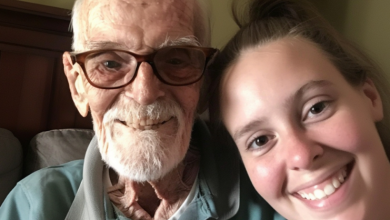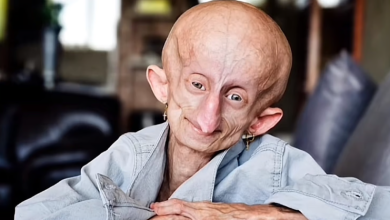It began on an ordinary Tuesday, the kind that starts with spilled cereal and ends with a hurried goodbye at the school gates. Natalie Reed was tying her six-year-old daughter Ila’s shoes when Ila tugged at her sleeve and said, “Mommy, I met someone today who looks just like me.” Distracted, Natalie smiled and replied, “Oh, really?” But Ila was insistent: “No, Mommy. It’s like looking in a mirror.”

Natalie froze, her fingers pausing mid-tie. There was something in Ila’s tone—so certain, so still—that sent a chill down her spine. Later that day, standing at the school gates, Natalie watched as children poured out of classrooms in a wave of laughter and color. And then she saw her. Walking hand in hand with Ila was another little girl—same height, same face, same dimple on the left cheek, and even the same birthmark on the right collarbone. It wasn’t just a resemblance—it was like seeing two Ilas side by side.
Natalie’s legs felt weak. Ila beamed, “Mommy, this is Ava.” Ava gave a shy wave. A nearby teacher noticed Natalie’s confusion and asked if everything was alright. “Who is that child?” Natalie whispered. “That’s Ava Coleman,” the teacher replied, “she’s new—just transferred two weeks ago. Sweet girl. Her foster parents say she’s been in the system for a while. She was abandoned at a hospital as a newborn.”
Natalie’s heart pounded. That night, she sat in her bedroom, staring at Ila’s baby pictures, remembering every second of her daughter’s birth—the fear, the joy, the chaos in the NICU. She remembered the nurse rushing in, the code blue, the alarms, the confusion, and then only one baby handed back. They told her that one of her twins hadn’t survived. She believed them because she had to.
But now, seeing Ava—her daughter’s mirror—Natalie couldn’t ignore what her heart already knew. The next morning, she requested a voluntary DNA test, comparing Ila’s cheek swab to Ava’s, with the foster family’s permission. She told no one, not even Ila. As she waited for the results, every glance at Ila felt like staring into a mystery she never meant to unlock.
Days passed in a blur. Natalie cleaned obsessively, cooked too much food, called her sister just to hear a familiar voice. Nothing could distract her from the ticking clock. Then, finally, the email arrived: “DNA Test Results: Ava Coleman & Ila Reed.” Natalie’s hands shook as she opened it, her heart pounding. The result: “Probability of full sibling match: 99.999987%. Relationship: Monozygotic twins (identical).”
Natalie dropped her laptop and sank to the floor, sobbing. She hadn’t cried when they told her her other twin was gone—back then, she was too numb with grief. But now, the truth broke her open. Ava was her daughter—her real daughter, her blood, her baby. She had been alive all this time, lost in the foster system.
Natalie’s mind raced back to the NICU, the confusion, the nurse’s panicked face, the way she’d only held one baby. Ava had never died—she’d been taken, by accident, by negligence, or perhaps something else. Natalie didn’t know how, but she knew one thing: she was going to get her daughter back.

That afternoon, Natalie contacted the foster agency. Her voice was steady. “I need to speak with someone immediately. It’s about Ava Coleman. I have her DNA test results. She’s my daughter.” There was a gasp on the other end, then, “Please hold, I’m transferring you to legal.” Within hours, a meeting was scheduled. Paperwork flew, a caseworker visited her home, questions were asked, documents exchanged. Natalie learned that Ava had been found as an infant wrapped in a hospital blanket, left at a fire station at 3 a.m.—no ID, no file, no parent. Only now did anyone connect the dots.
Natalie didn’t care about lawsuits or explanations. She just wanted her daughter. She was granted supervised visitation. When she walked into the foster center, Ava was sitting quietly with a book. The moment Ava saw Natalie, her face lit up. “I know you,” Ava said softly. “You’re mommy.” Natalie knelt, eyes full of tears. “No, baby,” she whispered, “I’m your mommy too.” Ava stared at her, then slowly smiled and said the word that broke Natalie all over again: “Home.” Natalie nodded, voice trembling. “Yes, sweet girl. Home.”
They hugged for the first time, not as strangers, but as mother and daughter reunited after six stolen years. What Natalie didn’t know was that someone else knew about the switch—someone who had kept it buried for years and was about to come forward.
Three weeks after discovering the truth, supervised visits turned into sleepovers. Ila and Ava were inseparable—two halves of one soul, pieced back together. Natalie would find them curled up in the same blanket, whispering secrets as if they’d known each other since birth. But even as the girls healed, Natalie couldn’t rest. She had questions no one could answer—until a letter arrived in an unmarked envelope.
The handwriting was shaky. “Ms. Reed, if you’re reading this, then you’ve already discovered that Ava is yours. I have no excuse for what I did, but I have a truth that’s haunted me for six years. I was the night nurse at Ridgewood Hospital the day your twins were born. There was chaos—one baby struggling, one stable, machines beeping, a code called for another baby.
In the confusion, I made a mistake. One nurse handed me your healthy baby for monitoring. When I returned, I was told your twin had already coded and passed, but I knew that wasn’t the baby I’d taken. I told my supervisor, pleaded for someone to double-check. They dismissed me, said I was sleep-deprived, said it was too late. The body had already been documented, the birth record sealed. So I shut my mouth.
For six years. A month later, I saw a news report—a baby girl found at a fire station, wrapped in a hospital blanket. I knew it was her, but I was too afraid to come forward. Now, as I write this, I’m terminal—stage 4 cancer. Nothing left to protect but my soul. Please forgive me. Her name was Ava before anyone named her Ava. It was written in your hospital notes, in your handwriting.”
Natalie sat frozen, the letter shaking in her hands, the words blurring with tears. She remembered writing “Ila and Ava always together” in the baby book, wanting them to have matching bracelets, choosing their names to sound like a pair. The world had torn them apart before they had the chance.
The next day, Natalie brought the letter to the foster care board. Weeks of meetings and hearings followed. Then, one morning, the phone rang. “Ms. Reed? Your petition for full and permanent custody of Ava has been approved.” Natalie collapsed onto the floor, laughing and crying all at once. When Ava walked through the front door that evening with her little suitcase, Natalie dropped to her knees and whispered, “This is your forever home.” Ava ran into Natalie’s arms and didn’t let go.
That night, Natalie took out the baby book she thought she’d never finish. She taped in a photo of the girls—two radiant smiles, two heads leaning together, one heart finally whole. Underneath, she wrote: “Day 2,191: Ava came home.”
As the girls played outside, Natalie watched from the porch, one hand on her heart, thinking of the nurse, the years lost, the milestones missed, but also about grace and second chances. She called out, “Girls, come inside! Dinner’s ready.” They ran toward her, hand in hand, laughter echoing through the yard—twin hearts, one family, and a mother who never stopped believing.







